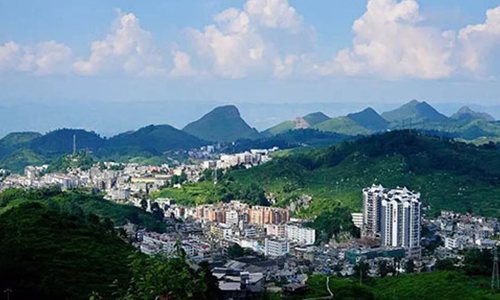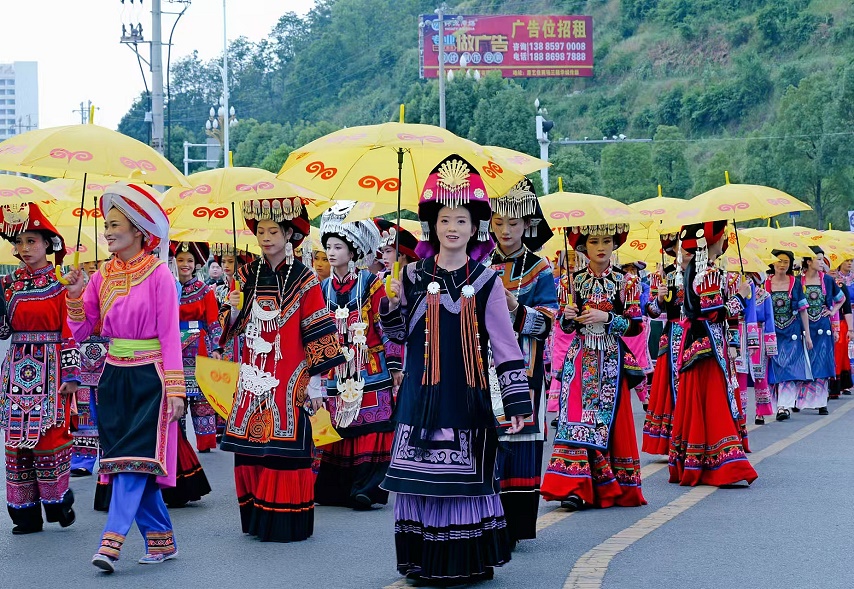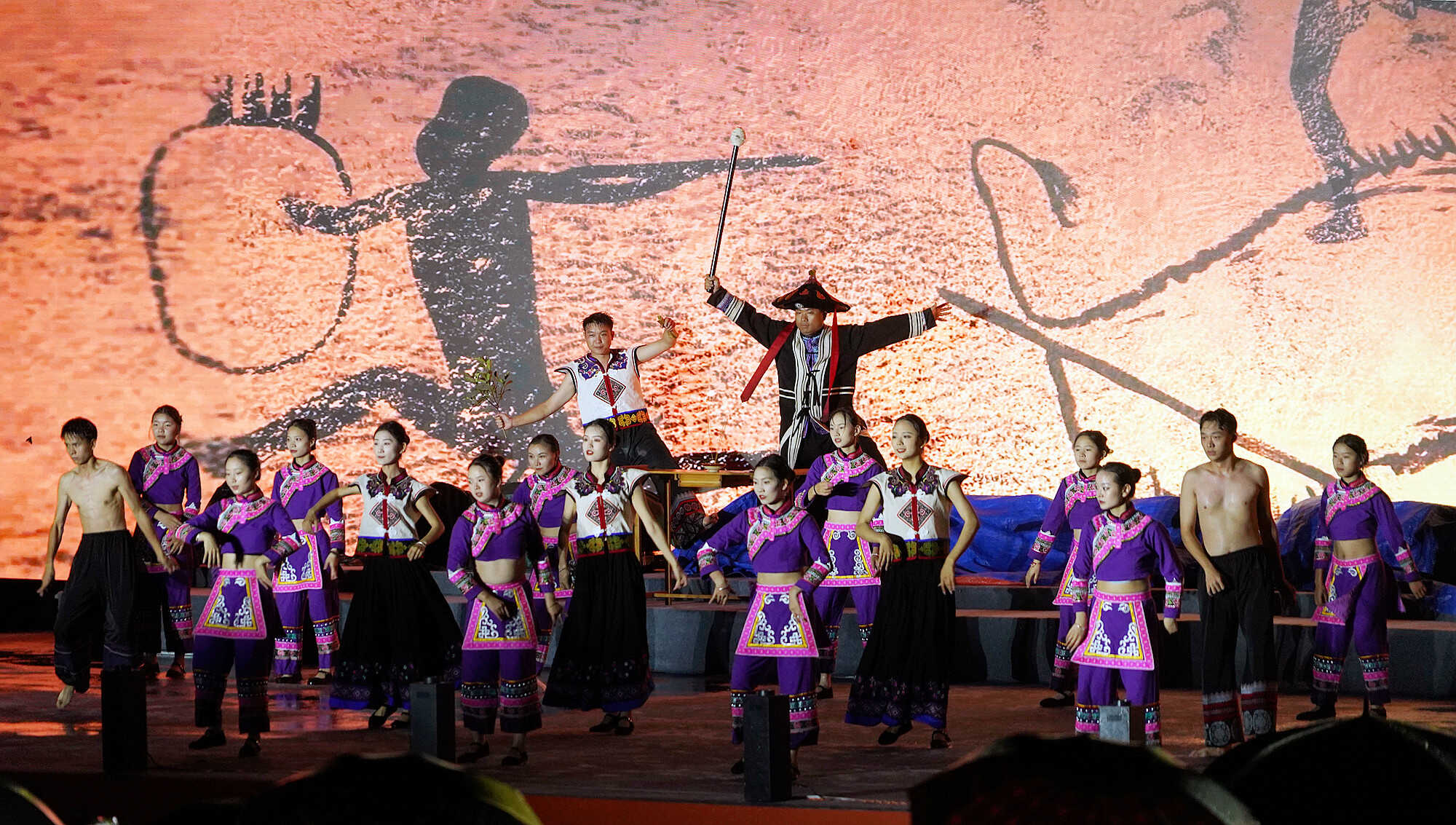- Profile Jurisdictions GOV DEPARTMENTS Cultures Travelling Educate
-
I. Basic Information
Qinglong County is situated in the southwestern part of Guizhou Province, at the northeastern corner of Qianxinan Buyi and Miao Autonomous Prefecture. It lies between 25°33' and 26°11' north latitude and 105°01'2" and 105°25' east longitude. The county spans 69 kilometers from north to south and 33 kilometers from east to west. Located in the central section of the Yungui Plateau, it belongs to the Beipanjiang River basin within the Pearl River system. The county borders Guanling Buyi and Miao Autonomous County across the river to the east, shares boundaries with Shuicheng and Liuzhi counties to the north via the river, adjoins Xingren City to the south, and connects with Puan County to the west. The Shanghai-Kunming Expressway spans 198 kilometers from Qinglong to the provincial capital Guiyang and 340 kilometers from Qinglong to Kunming, Yunnan. National Highway 320 runs 247 kilometers from Qinglong to Guiyang. The Qingxing Expressway connects Qinglong to Xingyi City (prefecture capital) over 136 kilometers, with 166 kilometers of inter-county roads. The county spans 69 kilometers north to south and 33 kilometers east to west, covering a total land area of 1,327.3 square kilometers. It comprises 142,300 mu of dryland, 68,700 mu of paddy fields, with 211,000 mu suitable for grain cultivation, over 200,000 mu suitable for forestry, and over 100,000 mu suitable for pasture.

Qinglong County exhibits a topography that slopes from west to east and from south to north. The highest point is located approximately 1 kilometer north of the Dijiuyue Chaotian area near the border with Puan County, at an elevation of 2,025 meters. The lowest point is at the confluence of the Masha River and the Beipan River, at an elevation of 543 meters. The elevation difference is 1,482 meters. Due to the incision by the Beipan River and its tributaries, the cutting depth reaches 500 to 700 meters, forming a deeply incised karst eroded mountainous area. The county features highly undulating terrain characterized by “lofty mountains, deep valleys, and steep slopes.” Its hydrology, soils, and vegetation exhibit complexity with pronounced internal variations. The county can be divided into five distinct geomorphological zones: low-mountain eroded terrain with canyons, karst plateau with troughs and terraces, karst-eroded plateau, karst-eroded mountainous areas, and eroded mountainous river valleys. Soil resources exhibit diverse classifications and types, predominantly acidic and slightly acidic red-yellow soils. The county's climate falls within the subtropical humid zone, characterized by abundant heat. Annual average sunshine hours range from 1,454 to 1,714 hours, with a perennial average temperature of 14.0°C to 14.7°C. Rainfall is plentiful, with an annual average precipitation of approximately 1,590.7 mm. Rainfall coincides with the warm season, and the frost-free period lasts 250–320 days. The climate is warm and humid year-round, with mild winters and cool summers. Fifteen rivers flow into the Beipan River within the county, forming the Beipan River basin. Excluding the Beipan River's drainage area, these fifteen rivers have a combined length of approximately 230 kilometers. The county's total catchment area is 1,325 square kilometers, with a hydropower storage capacity of 78,000 kilowatts. The region is rich in mineral resources, including over 30 types of natural ores such as gold, coal, antimony, iron, lead, zinc, manganese, copper, fluorite, jadeite, and marble. Its antimony reserves rank first in Guizhou Province and second nationwide. Proven coal reserves stand at 2.918 billion tons, with potential reserves exceeding 5 billion tons. Coal deposits are found in 10 of the county's 15 townships (subdistricts), characterized by high quality and substantial reserves. Gold deposits exist in 4 townships, featuring high grades and ease of extraction. Antimony, zinc, copper, and other minerals are present in 3 townships. Qinglong County's diverse climate provides excellent conditions for biological growth and reproduction. The region boasts a rich variety of biological resources, with abundant tree species. Major plants include over 760 species across 375 genera and 150 families, with most forests being natural secondary forests. Primary tree species comprise pines, oaks, birches, catalpas, zelkovas, and firs. Rare species include ginkgo, cycads, and areca palms, among over 20 others. Medicinal plants include gastrodia, eucommia, notoginseng, phellodendron, ganoderma, epimedium, pinellia, and arisaema, among numerous other species used in traditional Chinese medicine. Nearly 10 rare wild animal species inhabit the county. Grain crops primarily consist of rice, corn, wheat, and coix seed, followed by tubers and legumes, with scattered cultivation of sorghum, chestnuts, and other minor grains.
II. Administrative Divisions
As of the end of 2024, the county's total population was 346,100. Among them, the urban population was 95,600, accounting for 28% of the total population. The county administers 8 towns, 3 townships, and 4 subdistricts:
Changliu Township, Zhongying Town, Huagong Town, Chama Town, Guangzhao Town, Shazi Town, Bihen Town, Dachang Town, Jichang Town,
Liancheng Subdistrict, Dongguan Subdistrict, Sanbao Subdistrict, Tenglong Subdistrict,
Angu Township, and Zima Township.
These administrative units encompass 106 villages (communities).
III. Historical Development
Since the Qin and Han dynasties, the county territory has been part of Yelang, Tanzi, Loujiang, and Bengu counties. In the 25th year of the Hongwu reign of the Ming Dynasty (1392), Annan Garrison was established. In the 26th year of the Kangxi reign of the Qing Dynasty (1687), the garrison was abolished and Annan County was founded. In the 30th year of the Republic of China (1941), Annan County was renamed Qinglong County, a name that remains to this day. The county boasts significant historical and cultural sites including the Qinglong 24 Hairpin Turns, the Panjiang Iron Chain Bridge, Ming and Qing dynasty Panjiang cliff inscriptions, and ancient tomb clusters, all possessing considerable archaeological value.

IV. Natural Geography
Qinglong County exhibits a topography that slopes from west to east and from south to north. The highest point lies approximately 1 kilometer north of the May Sky-Facing Peak at the Puyuan County border, reaching 2,025 meters above sea level. The lowest elevation is at the confluence of the Mashi River and the North Panjiang River, at 543 meters. This creates an elevation difference of 1,482 meters. Deeply incised by the North Panjiang River and its tributaries, the terrain features cuts reaching 500–700 meters in depth, forming a deeply dissected karst erosion landscape. The county features highly undulating terrain characterized by “lofty mountains, deep valleys, and steep slopes.” Its hydrology, soils, and vegetation exhibit complexity with pronounced internal variations. The county can be divided into five distinct geomorphological zones: low mountain eroded terrain and canyon areas, karst plateau trough and terrace zones, karst eroded plateau areas, karst eroded mountain regions, and eroded mountain river valley zones. Soil resources exhibit diverse classifications and types, predominantly acidic and slightly acidic red-yellow soils. The county's climate falls within the subtropical humid zone, characterized by abundant heat. Annual average sunshine hours range from 1,454 to 1,714 hours, with a perennial average temperature of 14.0°C to 14.7°C. Rainfall is plentiful, with an annual average precipitation of approximately 1,590.7 mm. Rainfall coincides with the warm season, and the frost-free period lasts 250–320 days. The climate is warm and humid year-round, with mild winters and cool summers. Fifteen rivers flow into the Beipan River within the county, forming the Beipan River basin. Excluding the Beipan River's drainage area, these fifteen rivers have a combined length of approximately 230 kilometers. The county's total catchment area is 1,325 square kilometers, with a hydropower storage capacity of 78,000 kilowatts. In response to the national Western Development Strategy and the East-West Power Transmission initiative, the Guangzhao Hydropower Station was constructed.
V. Cultural Tourism
Successfully hosted 24 cultural and sports events, including the national “Four Seasons Village Evening” demonstration series, the 14th Yi Ethnic Torch Festival, and the 2nd Twenty-Four Turns Mountain Trail Run (Rainbow Run). Received 2.7898 million tourists, a year-on-year increase of 13.75%; tourism revenue reached 2.566 billion yuan, up 15.34% year-on-year. The square dance performance “Amei Qituo” was selected as a finalist for the 17th China Folk Art Mountain Flower Award in the category of Outstanding Folk Art Performance.
VI. Ethnic Population
For detailed data, please refer to the Qionglong County Seventh National Population Census Bulletin.
VII. Livelihood Security
Expenditures for basic livelihood safeguards reached 569 million yuan, accounting for 29.15% of the “three guarantees” expenditures. A total of 13,026 households (32,027 individuals) across the county were included in the urban and rural minimum living security system, with cumulative disbursements of 164 million yuan in minimum living allowances and 5.45 million yuan in temporary assistance funds. Livelihood policies such as assistance and support for persons in extreme poverty, nursing subsidies for persons with disabilities, and assistance for orphans and children effectively deprived of parental care were effectively implemented.
VIII. Social Undertakings
Educational quality continues to improve. A total of 62.52 million yuan was invested in 44 educational projects, including the relocation of Qinglong County Third Primary School, adding 2,505 new school places. Deepening “cluster-based” educational assistance, the county achieved a gross enrollment rate of 94.51% for three-year preschool education, a retention rate of 95.03% for nine-year compulsory education, and a gross enrollment rate of 92.33% for senior high school education. The undergraduate college entrance examination pass rate reached 49.38%, a 13.33% increase year-on-year; vocational education employment rate stood at 96%. A total of 43.765 million yuan in educational subsidies was distributed, benefiting 60,683 students. Healthcare services were continuously strengthened. The county people's hospital renovation and expansion project was completed and put into use, while the county traditional Chinese medicine hospital commenced operations. A “1+3+N” integrated county-level medical consortium model was established for coordinated development. Deepened “East-West Collaboration” and “Group-Based Assistance” in healthcare, establishing a specialty alliance with Guizhou Medical University Affiliated Hospital. Completed five major emergency and critical care centers, passing provincial assessment and acceptance. Completed “group-based assistance” for medical talent development, training and guiding 36 individuals. Basic medical insurance coverage reached 296,100 people countywide, with 100% coverage for poverty-stricken populations and special groups. Annual medical visits (including outpatient) reached 821,900, with comprehensive medical insurance reimbursement totaling 310 million yuan. Employment services were continuously optimized. The county achieved 4,481 new urban jobs, 735 re-employed unemployed individuals, 450 re-employed individuals with employment difficulties, 6,929 transferred rural laborers, and 17,725 organized out-of-province employment placements. A total of 96 entrepreneurial guarantee loans worth 23.81 million yuan were issued, creating 237 jobs. Twenty employment assistance workshops (bases) were designated, cumulatively absorbing 1,485 employees (including 431 formerly impoverished workers). One-time transportation subsidies totaling 15.646 million yuan were disbursed to 31,292 formerly impoverished workers.
IX. Rural Industrial Revolution
Vigorously developed specialty brands such as green tea and navel oranges, while continuously expanding advantageous agricultural industries including Sichuan pepper, coix seed, edible fungi, and premium fruits. Total output value of agriculture, forestry, animal husbandry, and fisheries reached 4.469 billion yuan, up 3.7%. Cumulative tea plantation area reached 165,000 mu (10,333 hectares) with total output of 5,500 tons; cumulative vegetable planting area reached 86,000 mu (5,733 hectares) with total output of 136,600 tons; Premium fruit cultivation reached 47,900 mu with a total output of 25,600 tons. Three new provincial-level leading enterprises were added. Qinglong County was included in the 2024 list of key tea-producing counties (formerly the Top 100 Counties), and “Guilong Xiaolanhua” won the first prize for “Guizhou Green Tea” product quality in 2024. “Qinglong Huangcha” and “Qinglong Hungshuangli” were selected for the national catalog of famous, special, superior, and new products. Dispatch of 42 science and technology specialists in a “group-based” assistance model to promote agricultural revitalization through science and technology.
X. Economic Development
The county's GDP surpassed the 10 billion yuan threshold for the first time, reaching 10.005 billion yuan with a growth rate of 1.6%, an increase of 1 percentage point compared to 2023. Specifically: Primary, secondary, and tertiary industries contributed ¥2.623 billion, ¥2.318 billion, and ¥5.064 billion respectively, with growth rates of 3.5%, 0.9%, and 0.8%. General public budget revenue reached ¥401 million, growing by 3.8%. Per capita disposable income for urban and rural residents increased by 3.9% and 7% respectively.
XI. Urban and Rural Development
The Naqing Expressway (Qinglong section) was completed and opened to traffic. Construction commenced on five rural transportation infrastructure projects under the first batch of new loans for connectivity, including the Bihen-Qingkou section. The Zhongying-Hagong rural road project accelerated. A total of 51.4 kilometers of rural road safety protection projects were completed, and four dangerous bridges were renovated. The water supply pipeline network supporting Gamu Village in Dachang Town and 31 small-scale water supply projects were completed, while 35 rural water supply projects underwent maintenance and upgrades. The Shangheqing Water Diversion Project and Baishui Reservoir Water Diversion Project were completed and put into operation. Urban renewal progressed steadily. Secured funding of 141 million yuan to advance eight key projects in an orderly manner, including the 2022 Liancheng Shantytown Renovation, 2023 Urban Shantytown Renovation, and 2022 Sanbao Industrial Park Affordable Rental Housing. Urban flood control and drainage projects advanced systematically. Construction commenced on the 2017 Urban Supporting Infrastructure Project (Road No. 15), while preliminary work accelerated for the Central District Comprehensive Parking Lot and Old Town Agricultural Market with supporting facilities.
XII. Environmental Protection
Completed 75.3 kilometers of urban sewage pipelines; Completed 6.67 square kilometers of rock desertification remediation, 10.8 square kilometers of soil erosion control, and afforestation of 10,000 mu (667 hectares). The county's air quality excellence rate reached 99.5%. Surface water quality at assessment sections—including river outflow sections, lake/reservoir vertical sections, centralized urban drinking water sources, and rural water sources serving over 1,000 people—maintained a 100% compliance rate.

XIII. Reform and Opening Up
We firmly uphold the “Two Establishments” and resolutely achieve the “Two Safeguards.” We strictly adhere to the leadership of the County Party Committee and rigorously implement the reporting system for major matters. We fully implement the responsibility system for ideological work and conduct in-depth education on Party discipline. We comprehensively strengthen Party conduct, integrity, and the fight against corruption, focusing on rectifying misconduct and corruption affecting the public. We have implemented 15 specific practical projects benefiting the people at all levels. We consistently administer governance according to law and accept supervision. Deepened law-based administration and advanced the construction of a law-based government. Intensified the “Eighth Five-Year” legal education campaign, strictly enforced decision-making procedures for “major decisions, important personnel appointments, major projects, and large-scale expenditures,” and maintained government transparency. Proactively accepted legal oversight from the People's Congress and democratic oversight from the CPPCC, completing 85 proposals from People's Congress deputies and 61 proposals from CPPCC members on schedule. Remained diligent and committed to delivering tangible results. The Fifth National Economic Census was fully completed. We adhered to a “frugal approach,” reducing “three public expenditures” by 5.4%. We vigorously promoted the work style of “immediate action and solid execution,” handling 5,197 public complaints through the 12345 platform. We comprehensively advanced efforts to eliminate formalism and reduce burdens on grassroots levels, reducing the number of documents issued and meetings held by 9% and 11% year-on-year, respectively.
XIV. Prospects and Goals
The primary expected targets for economic and social development in 2025 are:
- Annual regional GDP growth of approximately 6%, with primary, secondary, and tertiary industries growing by about 4.1%, 11.8%, and 4.4% respectively; Total output value of agriculture, forestry, animal husbandry, and fisheries to grow by about 4% at comparable prices, with above-scale industrial added value increasing by about 20%; Fixed-asset investment to grow by about 6%; Total retail sales of consumer goods to increase by about 5%; General public budget revenue to rise by about 2%; New urban employment to exceed 4,200 persons; Per capita disposable income growth for rural and urban residents to reach about 7% and 5.5%, respectively.
contact details
Tel:00-86-0859-7611832
Address:No. 9, Sunshine Road, Northeast Community, Dongguan Street, Qinglong County, Guizhou Province, China
Working hours:Weekdays (08:30-12:00 14:30-18:00)
